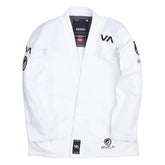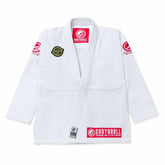Which Muscles Are Used the Most in Brazilian Jiu-Jitsu?
Brazilian Jiu-Jitsu (BJJ) is one of the most physically and mentally demanding martial arts in the world. Practitioners often speak about the technical finesse, the strategy and the endurance needed to succeed on the mats. But underneath all that skill lies a foundation of muscular strength and conditioning. It does not matter if you are wearing a Gi or training No-Gi. Your body goes through rigorous physical activity that targets multiple muscle groups simultaneously.
In this article, we will break down which muscles are used the most in Brazilian Jiu Jitsu. Moreover, we will explain how they function during rolls and drills. Besides, it will explore why understanding muscle involvement is key for improving performance, reducing injuries and optimizing your training. Whether you are a white belt or a seasoned black belt, knowing how your body moves in BJJ can give you an edge.
The Full-Body Nature of BJJ
Unlike isolated weightlifting movements, BJJ is a full-body workout. Every sweep, escape, submission or guard pass uses a coordinated effort of several muscle groups. Your limbs do not work in isolation—they pull, push, bridge or rotate in sync. Thus, making compound muscle engagement the standard.
Training in BJJ—whether with a Gi or without—means developing functional strength, flexibility and endurance. The goal is not just big muscles. But well-coordinated muscles working together under stress, fatigue and resistance.
Guide > Best Workouts for Brazilian Jiu Jitsu Athletes
Primary Muscles Used in Brazilian Jiu-Jitsu
Let’s break down the main muscle groups involved in BJJ and explain how each contributes to the art.
1- Core Muscles: The Engine Room of BJJ
Key Muscles: Rectus abdominis, obliques, transverse abdominis, lower back (erector spinae)
The core is arguably the most important muscle group in BJJ. It stabilizes the body during movement, bridges, transitions and guard retention. Whether you are shrimping, inverting or defending against a pass, your core keeps your body tight and controlled.
Role in BJJ:
- Shrimping and hip escapes rely heavily on oblique and transverse abdominis strength.
Bridging during mount escapes uses the glutes and lower back along with the core. - Maintaining posture in closed guard or breaking posture as the attacker requires a strong core foundation.
Training tip: Add planks, leg raises, and rotational core work to boost your BJJ performance.
2- Back Muscles: The Pulling Power
Key Muscles: Latissimus dorsi, trapezius, rhomboids
Your back muscles play a significant role in pulling, controlling grips and executing submissions like collar chokes or armbars. Especially in Gi-based BJJ, where gripping sleeves and lapels is common, the lats and traps are constantly engaged.
Role in BJJ:
- Pulling opponents close in closed guard.
- Executing takedowns like double-leg or single-leg shots.
- Controlling the upper body from back control or top mount.
- Breaking posture using lapel grips from the guard.
A strong back ensures your ability to maintain pressure and leverage during rolls.
3- Legs and Glutes: The Base and Drive
Key Muscles: Quadriceps, hamstrings, gluteus maximus, adductors
Whether you are playing guard or trying to pass it, your legs are always working. Leg dexterity and strength are essential for sweeping, retaining guard and applying submissions like triangles or leg locks.
Role in BJJ:
- Closed guard strength requires active adductors and hamstrings.
- Butterfly guard uses the hip flexors and glutes for elevation and control.
- Passing guard involves explosive hip movement and driving force through the legs.
- In takedowns, the legs provide the base and explosive energy.
To dominate in BJJ, your lower body must be strong, flexible, and responsive.
4- Shoulders and Arms: Grip, Frames, and Submissions
Key Muscles: Deltoids, biceps, triceps, forearms
Your arms are not just for punching in MMA. They are for framing, posting and choking in Brazilian Jiu Jitsu. Your shoulders and arms absorb pressure and help maintain structure in positions like side control, guard and mount.
Role in BJJ:
- Framing during guard retention or escapes.
- Pummeling for underhooks or overhooks in clinch.
- Setting up submissions like kimuras, arm drags or guillotines.
- Posturing and basing during positional changes.
Grip strength in particular is crucial, especially in Gi BJJ where sleeve and lapel grips dominate exchanges.
Training tip: Incorporate farmer’s carries, pull-ups, and grip-specific tools (like gi sleeve pull-ups) to enhance endurance.
5- Neck Muscles: The Unsung Heroes
Key Muscles: Sternocleidomastoid, upper trapezius, deep neck flexors
Your neck muscles are constantly under pressure in Brazilian Jiu Jitsu, especially during guillotine defenses, bridging and turtling. A strong neck helps prevent injuries and contributes to overall posture and resistance to submissions.
Role in BJJ:
- Defending chokes and cranks.
- Maintaining head posture in turtle or during scrambles.
- Bridging with head support when escaping bottom positions.
Neglecting neck strength can lead to chronic strain or increased injury risk.
Guide > 5 Most Common Jiu-Jitsu Injuries, Causes, and Prevention
Gi vs No-Gi: Does Muscle Engagement Change?
While the major muscle groups remain the same, Gi and No-Gi training emphasize different aspects of muscle use.
- Gi BJJ relies heavily on grip strength and static holds, which engage the forearms, back and shoulders extensively. Gi grips also slow down the pace, allowing more time for muscle tension to build up.
- No-Gi BJJ, being faster-paced and more scramble-heavy, emphasizes explosive movement, hip mobility and core control. Here, wrestling-style takedowns and transitions demand more from the legs and core.
Training both styles ensures a well-rounded muscle development and better athletic adaptability.
Why Knowing Your Muscle Engagement Matters
- Understanding which muscles are most involved in BJJ helps you:
- Target your strength and conditioning routines effectively.
- Prevent injuries by strengthening vulnerable or underused muscle groups.
- Improve recovery by focusing on the muscles most prone to fatigue.
- Train smarter, not just harder, by focusing on movement efficiency.
If you are just doing generic gym workouts, you are missing out on sport-specific development. Knowing that your core, back and legs dominate in BJJ should shape how you plan your training week.
Muscle Fatigue and BJJ Performance
Ever rolled for a few minutes and felt your grips die out or your legs turn to jelly? That is muscle fatigue—and in BJJ, it shows up fast when you are not conditioned properly.
Common fatigue points:
- Forearms and grip—due to constant tension in Gi-based grappling.
- Hips and glutes—from explosive bridges or hip escapes.
- Lower back—from maintaining posture, especially in guard.
- Core—from continuous transitions and retention.
That is why BJJ-specific strength and conditioning is essential for performance and injury prevention.
Conclusion: Train the Way You Grapple
Brazilian Jiu-Jitsu, whether in a Gi or No-Gi, is a physically demanding art. It uses nearly every muscle group in your body. The core, back, legs and grip muscles are especially crucial for executing techniques and maintaining control.
Understanding how these muscles work allows you to train with purpose, focus your energy where it counts and perform better on the mats. It does nott matter Whether you are rolling for fitness, competition or self-defense. Integrating sport-specific muscle training into your routine can take your BJJ journey to the next level.
Ready to roll stronger, longer, and smarter? Start training the muscles that matter most.







